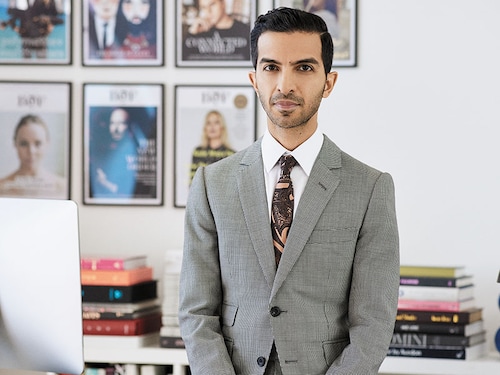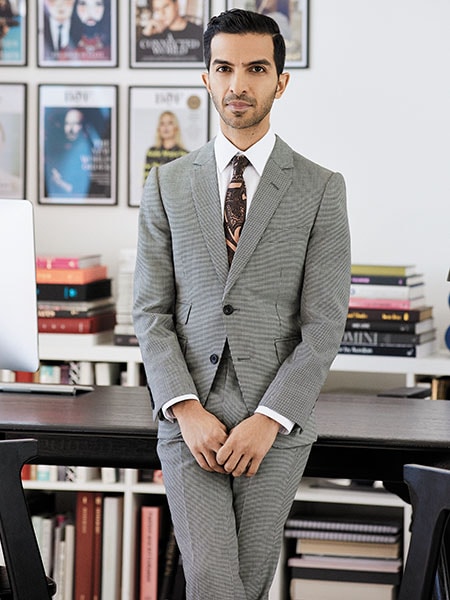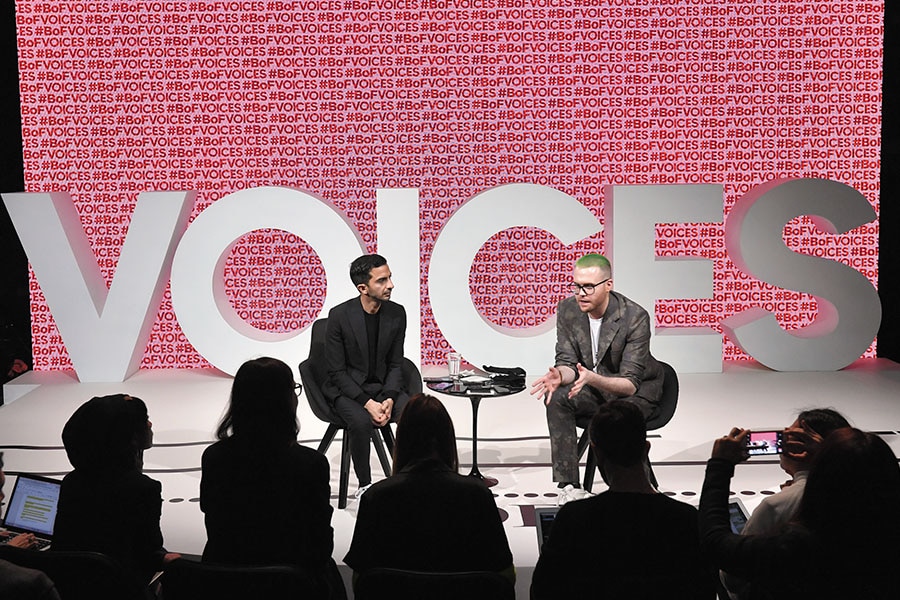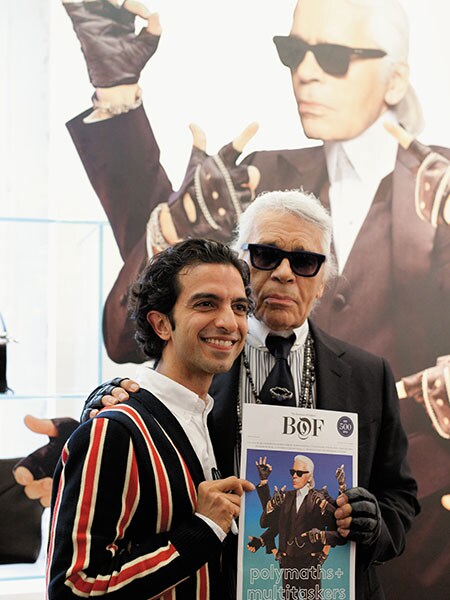How Imran Amed became one of the sharpest voices in fashion
The Indian-origin founder, CEO and editor-in-chief of The Business of Fashion, is focused on spotlighting the grime behind the glitz


 Imran Amed, Founder and CEO of The Business of Fashion
Imran Amed, Founder and CEO of The Business of Fashion
Image: Philip Sinden
Imran Amed’s Instagram page is colourful. For the fashion industry commentator and founder-CEO of the popular and influential blog-turned-media company, The Business of Fashion (BoF), the shades pour in from various quarters, well beyond the spring-summer runway. While one post highlights the story of Bangladeshi activist Kalpona Akter, fighting for the rights of garment workers in her country, another tells the tale of disruptor Virgil Abloh, the Ghanian-American founder of Off-White, a label that’s now a sensation in luxury streetwear.
In a post from last September, a white T-shirt hangs against a white background, with bold black text: Fashion hates Brexit. His detailed caption says, “An exit from the EU without a deal would irrevocably harm the future of the British fashion industry. Sadly, growing anti-immigration sentiment threatens the very core of what makes London a global fashion capital…” Amed followed this up a few weeks later with a photo with British fashion designer and activist Katharine Hamnett, known for making political comments through her collections, and both can be seen wearing the same Brexit T-shirt in reverse colours, announcing a letter-writing campaign, asking BoF’s followers to write to their MPs and ask for a second referendum.
Travelling through Mumbai recently, Amed decided to put together a high-powered, private event at the last minute—a session on modern entrepreneurship with actor Deepika Padukone and designer Sabyasachi Mukherjee. “He pulled it off in a week,” says his publicist, with an air of disbelief. “He reached Deepika while she was at Cannes, walking the red carpet, but he has this way of making extremely busy people agile.”
While the discussion in Mumbai was on fashion and entrepreneurship, Amed managed to weave in social concerns too—mental health and the country’s stand on gay marriage, for instance.
Imran Amed’s BoF is no ordinary industry voice. Trawling through the website’s homepage, you will find its spotlight focussed on the following issues: The impact of Trump’s tariffs why beauty brands need to cater to women going through menopause (and banish the term ‘anti-ageing’, to allow them to age on their own terms) the use of underage models the urgency of climate action in the fashion industry.
“Given his McKinsey background, Amed brings in-depth research to every article in BoF. Everything featured provides a holistic overview of the industry, ranging from consumer needs to finance, to production ecosystems, markets, brands and creative individuals. The canvas is wide and in-depth,” says Mukherjee. “This provides incredible value to its readers.”
In an article last September, The Guardian called Amed “fashion’s most influential man”. I meet him first at the café-cum-workspace in Soho House in Juhu, and he arrives just slightly panting, dressed in an unassuming white T-shirt (sans political statements) and nattily striped lounge pants. “I’ve found a much nicer place for the meeting,” he greets me, eyes shining. We head up to the terrace café, where he has scoped out a corner table that definitely holds the best seats in the house. We’re now bordered with unobstructed swathes of sand and a refreshing panorama of the Arabian Sea. He takes in the landscape and settles down to order a green juice, “just something to get the morning started”. It’s not hard to see that Amed’s all about the details.
**** Amed at a Mumbai event with actor Deepika Padukone and designer Sabyasachi Mukherjee[br]BoF was never created in a lightbulb moment, Amed says. He had just quit his job as a management consultant at McKinsey and was evaluating how to intersect his interests in business along with those in creative industries, one of which was fashion. Back in 2006, Amed was in the process of starting a fashion incubator enterprise that didn’t quite work out.
Amed at a Mumbai event with actor Deepika Padukone and designer Sabyasachi Mukherjee[br]BoF was never created in a lightbulb moment, Amed says. He had just quit his job as a management consultant at McKinsey and was evaluating how to intersect his interests in business along with those in creative industries, one of which was fashion. Back in 2006, Amed was in the process of starting a fashion incubator enterprise that didn’t quite work out.
“Everyone wanted to share this new adventure I was working on. So, for purely personal reasons, and because it was easier than answering individual questions, I set up a blog about it,” he says. “It was password protected, and I would share my posts with friends and family. But through this, I found that I really liked creating posts—writing things down, uploading photos and so on—and when the incubator project didn’t take off, I disabled the password, deleted my old posts and then called the blog Business of Fashion.”
This was January 2007. As most blogs do, BoF began as Amed’s passion project. Over time, it began to grow. Amed was earning his living as a consultant by day, advising fashion houses such as LVMH and fashion entrepreneurs, and teaching. “People started asking me to do speaking and writing engagements. I had created a fun portfolio of activities that I really enjoyed, but the blog continued to grow,” he says.
“At the beginning I wrote about everything,” he adds. “I picked subjects based on feedback from readers, their comments and questions. BoF was very much built with the community in mind, a philosophy that drives us even today. In the digital era, you build a company with your customers, not for your customers, since there’s such a strong channel for feedback.”
An early series was called ‘The Business of Fashion Basics’, detailing how to set up a fashion business from scratch. “People wanted more of that. That became an eight-part series, which turned into a video series, and eventually, an online course,” says Amed.
About six years in, by 2013, investors started to approach Amed and asked him for his plan. That’s when he thought about making it his full-time focus, and took the plunge.
Now, BoF has a team of about 100 across London, New York, Paris and Shanghai, and a global contributor network. They are funded by investors such as Index Ventures (which has also backed Asos, Net-a-Porter, Facebook and Skype), Felix Capital (Deliveroo, Houzz and Gwyneth Paltrow’s Goop) and LVMH.
“BoF was global right from the beginning. The first few publications to reach out to me were Vogue Korea and South China Morning Post, about six months after I started the blog. I saw instantly that you could sit in your living room in London and speak to readers all over the world. This was before Facebook and Twitter took off in a big way. It was my first understanding of how technology would change the way we communicate,” Amed says.
BoF has experimented with various revenue models, and Amed says what’s really driving them now is digital subscriptions. “We have members in more than 125 countries. We have almost 600,000 email subscribers and our paid membership base is more than 35,000,” he says. Students can subscribe to the BoF Professional network for free. “We serve people right from the entry level to CEOs, and we follow them along the journey. So there are different products, content formats and events for different career stages,” Amed says.
So while some of BoF’s content is free, parts of it are behind a paywall. The website has some advertising, but it’s mostly B2B, from fashion schools, trade shows and so on. BoF also has a careers platform where brands pay an annual subscription to showcase company culture and list jobs on paid online courses an email newsletter with some advertising. It also hosts power-packed sponsored events, and releases a bi-annual print issue that is monetised. All of this means the majority of their revenue does not depend on advertisers.
“We’ve arrived at a point in the media timeline where people are willing to pay for content that they feel there is value in—look at precedents set by The New York Times or Financial Times, which are very much in line with what Netflix and Spotify are doing,” Amed says. “Our model differs from others in that we’re writing for a specific audience that has a specific need. This community has never been communicated to in the way we do. Pre-digital, there were local trade publications in various countries, but no one had communicated to the global community.”
Amed’s stress on diversity and a global outlook comes partly from his own mixed upbringing. He is of Indian origin, but his grandfather left Bombay in the 1920s to settle in East Africa, where he met Amed’s grandmother. Amed himself was born in Canada, but has lived in London for the better part of two decades now. “So I’m Indian by ethnicity, East African by heritage, Canadian by birth and British by citizenship,” he says. “Sometimes, astronauts go to space and they see that there are no lines on the map, and just see one world. That’s how I always saw the world, because that’s the way I was raised. Increasingly, that’s how the world operates. A decision made in one country has repercussions in others.”
“Some of the challenges that fashion companies have faced this year are a reflection of, in some respects, the lack of diversity in the teams that are making decisions. For instance, what products and what advertising to put out,” he adds. “So I do think it’s a competitive advantage in 2019 to have a really global, diverse group of people that make a company work, because you’re communicating with a global diverse community.” Amed speaks at the annual BoF Voices in Oxfordshire[br]The fine print
Amed speaks at the annual BoF Voices in Oxfordshire[br]The fine print
When BoF launched its print edition in 2013, it was just meant to be a one-off run—a way to announce their newly minted ‘BoF 500’, a list of 500 people shaping fashion. “This was our first big project shortly after we raised some funding,” Amed says. “Ours is still an industry that really responds to physical objects. So as a one-off, I approached [fashion designer and filmmaker] Tom Ford to convince him to be on the cover.”
At this point, there was no BoF magazine and nobody knew what the BoF 500 was, so to convince people to participate in this “secret project” was hard. “I don’t know why, but he agreed, and we went to print. The response was incredible. People love having this physical manifestation of their relationship with BoF, and you see it at the offices of CEOs and designers all over the world,” he says. Amed with late fashion designer and artist Karl Lagerfeld[br]Initially, it was printed twice a year to create attention around something BoF was launching. “Now, we’ve included them as part of our professional membership, so twice a year, our premium subscribers get the print issue, and if you check the hashtag that goes with it, you’ll see that they’re thrilled to post photos of it coming in the mail,” he adds. “It’s a nice way of having that connection with the community.”
Amed with late fashion designer and artist Karl Lagerfeld[br]Initially, it was printed twice a year to create attention around something BoF was launching. “Now, we’ve included them as part of our professional membership, so twice a year, our premium subscribers get the print issue, and if you check the hashtag that goes with it, you’ll see that they’re thrilled to post photos of it coming in the mail,” he adds. “It’s a nice way of having that connection with the community.”
“It also helps us get access to people. If we wanted to have an interview with [the late fashion designer and artist] Karl Lagerfeld or [tennis champion and fashion entrepreneur] Serena Williams, if you can offer a cover story, it has even more meaning. And it ups our game on the content side. It’s a win-win-win,” he adds.
The latest print issue has Williams on the cover, speaking about the trials and triumphs of running her fashion brand, S by Serena. A previous issue themed ‘The Age of Influence’ featured dual covers—with influencer Kim Kardashian West, and Sinéad Burke, a three-and-a-half-foot Irish teacher, broadcaster and activist, born with achondroplasia, a genetic disorder that results in dwarfism.
“No one in the industry was talking about dressing people with disabilities, and what their experiences were like in a retail environment, when the handles are too high and you can’t reach anything,” says Amed. He invited Burke to speak at BoF Voices, an annual event in Oxfordshire that aims to be like a ‘think tank’, bringing together decision-makers in fashion as well as other industries. While Burke spoke at one event, Christopher Wylie, the whistleblower behind the Cambridge Analytica scandal, spoke at another.
“He came to me with information about how fashion brands have been co-opted in the 2016 US presidential election,” says Amed. “Cambridge Analytica was using information about which brands people were following, and targeting them with ads to influence them to vote in a certain way. Fashion connects with everything. It’s an industry that employs tens of millions of people and it, quite literally, touches everyone. When you have that kind of visibility and connection with people, it’s powerful to use it to create conversations about various issues.”
First Published: Jun 13, 2019, 16:09
Subscribe Now